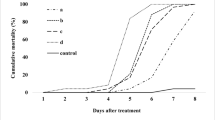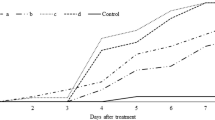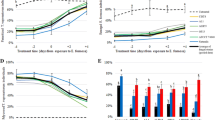Abstract
The efficacy of two Finnish strains of Metarhizium anisopliaeagainst the rape blossom beetle Meligethes aeneus (Coleoptera:Nitidulidae) and the effect on its parasitoids Phradismorionellus (Hymenoptera: Ichneumonidae) and Diospilus capito(Hymenoptera: Braconidae) were studied in laboratory and semi-fieldexperiments. Several bio-assays were performed using either directexposure of the host beetle to the pathogens, or pots containing soilinoculated with M. anisopliae conidia at a rate of 2 ×108 per ml soil. Parasitised and unparasitised M. aeneuslarvae were collected in the field and were placed for pupation in thetest soil. The effect of treatment on M. aeneus andD. capito was estimated after adult emergence, and the effecton P. morionellus was estimated by dissecting hibernating pupae.While both of the M. anisopliae strains were highly pathogenicto M. aeneus adults and larvae upon direct exposure, soiltreatment resulted in no significant difference between the number ofinsects emerging (or found) from the treated and untreatedpots. However, the treated insects appeared to be latently infectedand the actual infection rate had to be estimated after their deathand incubation in a moist chamber. The mortality of the beetles causedby direct exposure to the fungus was 85% (range 70–88%). The rateof latent infection following indirect exposure via treated soil indeep pots in laboratory was 80% (range 49–100%), while that inP. morionellus was only 17% (range 0–85%), and inD. capito significantly higher, 76% (range 72–100%).The results indicate that M. anisopliae is a potentially usefulcandidate to be used as a bio-insecticide to control the pollenbeetle, and that at least the most abundant parasitoid, Phradismorionellus, is less affected than the target pest itself. Thepossible ecological role of latent infections in the host as well asin some of the parasitoids needs to be clarified.
Similar content being viewed by others
References
Alves, S., L. Marchini, R. Pereira, and L. Baumgratz, 1996. Effects of some insect pathogens on the Africanized honey bee, Apis mellifera L. (Hymenoptera: Apidae). J. Appl. Ent. 120: 559–564.
Butt, T., I. Ibrahim, B. Ball and S. Clark, 1994. Pathogenicity of the entomogenous fungi Metarhizium anisopliae and Beauveria bassiana against crucifer pests and the honey bee. Biocontrol Sci. Technol. 4: 207–214.
Butt, T.M., N.L. Carrec, L. Ibrahim and I.H. Williams, 1998. Honey bee mediated infection of pollen beetle Meligethes spp. by the insect-pathogenic fungus, Metarhizium anisopliae. Biocontrol Sci. Technol. 8: 533–538.
Falcon, L., 1974. Insect pathogens: Integration into a pest management system. In: F. Maxwell and F. Harris (eds), Proceeding of Summer Institute of Biological Control of Plant Insects and Diseases. pp. 618–624.
Flexner, J., B. Lighthard and B. Croft, 1986. The effect of microbial pesticides on non-target, beneficial arthropods. Agric. Ecosys. Environ. 16: 203–204.
Fritzsche, R., 1957. Zur Biologie und ÖOkologie der Rapsschäadlinge aus der Gattung Meligethes. Z. angew. Ent. 40: 222–280.
Goettel, M., 1994. Host range and specificity in relation to safety of exotic fungi. 6th International Colloquium on Invertebrate Pathology and Microbial Control, 27th Annual Meeting of the Society for Invertebrate Pathology, Montpellier, France. pp. 325–329.
Goettel, M., T. Poprawski, J. Vandenberg, Z. Li and D. Roberts, 1990. Safety to nontarget invertebrates of fungal biocontrol agents. In: M. Laird, L. Lacey and E. Davidson (eds), Safety of Microbial Insecticides. CRC Press, Boca Raton, Fl. pp. 209–231.
Hajek, A. and R. Leger, 1994. Interactions between fungal pathogens and insect hosts. Annu. Rev. Entomol. 39: 293–322.
Hokkanen, H., 1993. Overwintering survival and spring emergence in Meligethes aenus: Effects of body weight, crowding, and soil treatment with Beauveria bassiana. Ent. Exp. Appl. 67: 241–246.
Hokkanen, H., G.-B. Husberg and M. Söoderblom, 1988. Natural enemy conservation for the integrated control of the rape blossom beetle Meligethes aeneus (F.). Ann. Agric. Fenn. 27(131): 281–294.
Hokkanen, H.M.T., 2000. The making of a pest: Recruitment of Meligethes aeneus onto oilseed Brassicas. Ent. Exp. Appl. 95: 141–149.
Husberg, G.-B., I. Väanninen and H. Hokkanen, 1988. Insektpatogena svampar och nematoder i odlingsjorden i Finland. Väaxtskyddsnotiser 52(1–2): 38–42.
Markkula, M., 1988. Pests of cultivated plants in Finland 1976–1988. Ann. Agric. Fenn. 16–27 (various issues).
Minitab, 1989. MINITAB Statistical Software, Reference Manual. Technical report, Minitab Inc., State College, PA, USA.
Moorhouse, E., A. Gillespie and A. Charnley, 1993. Laboratory selection ofMetarhizium spp.: Isolates for control of vine weevil larvae (Otiorhyncus sulcatus). J. Inv. Pathol. 62: 15–21.
Nilsson, C., 1988a. The pollen beetle (Meligethes aeneus F.) in winter and spring rape at Alnarp 1976–1978. I. Migration and sex ratio. Väaxtskyddsnotiser 52: 145–150.
Nilsson, C., 1988b. The pollen beetle (Meligethes aeneus F.) in winter and spring rape at Alnarp 1976–1978. II. Oviposition. Väaxtskyddsnotiser 52: 139–144.
Nilsson, C., 1988c. The pollen beetle (Meligethes aeneus F.) in winter and spring rape at Alnarp 1976–1978. III. Mortality factors. Väaxtskyddsnotiser 52: 145–150.
Rath, A., D. Worledge, T. Koen, and B. Rowe, 1995. Long-term field efficacy of the entomogenous fungus Metarhizium anisopliae against the subterranean scarab, Adoryphorus couloni. Biocontrol Sci. Technol. 5: 439–451.
Studdert, J.P., H.K. Kaya, and J.M. Duniway, 1990. Effect of water potential, temperature and clay coating on survival of Beauveria bassiana conidia in a loam and peat soil. J. Inv. Pathol. 55: 417–427.
Tulisalo, U. and T. Wuori, 1986. Blossom beetle Meligethes aeneus (Fab.) as a yield factor in turnip rape Brassica campestris (L.). J. Agric. Sci. Finl. 58: 221–237.
Väanninen, I., G.-B. Husberg, and H. Hokkanen, 1989. Occurence of entomopathogenic fungi and entomophilic nematodes in cultivated soils in Finland. Acta Ent. Fenn. 53: 65–91.
Väanninen, I., H. Hokkanen, and J. Tyni-Juslin, 1999. Attempts to control cabbage root flies (Delia radicum) L. and D. floralis (Fall.); Diptera: Anthomyidae) with entomopathogenic fungi. Laboratory and greenhouse tests. J. Appl. Ent. 123: 107–113.
Väanninen, I., J. Tyni-Juslin, and H. Hokkanen, 2000. Persistence of augmented Metarhizium anisopliae and Beauveria bassiana in Finnish agricultural soils. BioControl 45: 201–222.
Zimmermann, G., 1986. The ‘Galleria bait method’ for detection of entomopathogenic fungi in soil. J. Appl. Ent. 102: 213–215.
Author information
Authors and Affiliations
Corresponding author
Rights and permissions
About this article
Cite this article
Husberg, GB., Hokkanen, H.M. Effects of Metarhizium anisopliae on the pollen beetle Meligethes aeneus and its parasitoids Phradis morionellus and Diospilus capito. BioControl 46, 261–273 (2001). https://doi.org/10.1023/A:1011479616787
Issue Date:
DOI: https://doi.org/10.1023/A:1011479616787




